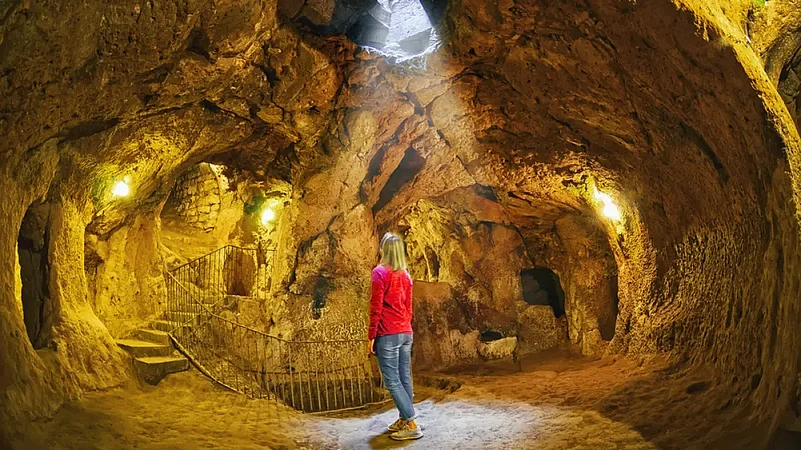China: Dixia Cheng, Beijing
Built in the 1960s as a nuclear war shelter, this underground city below Beijing occupies almost 85 square kilometre. Thankfully, there has been no occasion to use it, where a million people may shelter for four months. Now a tourist attraction, it contains granaries, schools, hospitals, restaurants, and entertainment venues, all connected through a network of tunnels and passages.
While you take a swig of the eponymous beer, don’t forget to descend to the underground city – Pilsen Historical Underground - which virtually grew out of the need to create storage areas for food and the beer barrels in the prehistoric age. Now converted to a museum, it can be explored on a guided tour.
Advertisement
Canada: Tunnels of Moose Jaw, Saskatchewan
Lying below the city is this network of passages which many claim to have been carved out by Chinese settlers in Canada as secret shelters when the Chinese Head Tax and other regulations were enforced. However, researchers have refuted these claims. In the 1920s, bootleggers found these tunnels a convenient way to beat the Prohibition orders – they would store the liquor in here and then carry it to the US via railroad. Again, there is no proof that Al Capone used to run the bootlegging business here. Today, private enterprise has carved a veritable world of entertainment by merging fact and fiction to offer tourists a guided walk through the passages and recreations which support the various claims.
Advertisement
France: Naours
According to archeologists, this underground city – likely inhabited by people in the 1th century – was carved out of a much older quarry. Large enough to accommodate 3,000 people, it had chapels, wells, stables, etc. But what makes this city interesting is the series of graffiti left behind by soldiers from different nations from the First World War. It is said that the soldiers, who were mostly on leave or recuperating, would be given a tour of this underground city. Till date, nearly 3,000 graffiti, the handiwork of soldiers from Australia, England, Ireland, Scotland, France and America, have been identified. Take a comprehensive tour of the area to know more.
Germany: Gesundbrunnen, Berlin
Tucked beneath Berlin is a maze of bunkers and other architecture, all reminders from the Second World War. Now, thanks to a group of concerned citizens, these secret places are now being explored and converted to museums depicting various historical events. The first Berlin bunker to be opened to the public is the one beneath the Gesundbrunnen train station. You will find gas masks, books and letters dating back to the days when they were treated as war shelters. You may join one of the tours to know more about its history and the exhibits.
Italy: Orvieto
Advertisement
A walk through the subterranean passages in this Italian town, better known for its white wine, reveals interesting snippets from the lives of the ancient Etruscans. Initially, the people dug beneath the surface to build wells and cisterns, and then began to create tunnels and galleries. Today, a guided walk is the best way to explore the unusual cultural aspect of a city, unraveling the mysterious and fascinating echoes of Etruscan Velzna, and brush past phantoms of the medieval and Renaissance city hidden among the damp shadows.
Poland: Wieliczka Salt Mine
This former salt mine would not have caught people’s attention if it was not for the artistic skills of the miners who worked here and, in their off duty hours, used the salt crystal deposits to carve out relief patterns to chandeliers, from chapels to a replica of Da Vinci’s Last Supper, etc. Even though mining has ceased since 2007 (after 700 years for continuous operation), this subterranean city runs across nine levels and includes 3,000 chambers. If you are in Krakow, do not miss this Underground Salt Cathedral.
Advertisement
Turkey: Derinkuyu, Cappadocia
This semi-arid region in central Turkey has an amazing number of subterranean cities. So if you have time to see only one, then head to Derinkuyu built during the Byzantine era. Interconnected through a network of tunnels, passages and ventilation shafts, the city lies nearly 60 metre below the ground and spreads over 18 storeys. Archeologists have found living space for nearly 20,000 people as well as chapels, kitchens, schoolrooms, refectories, a bathhouse, a winery, oil presses, etc.
United States: Shanghai Tunnels, Portland
While there are arguments galore about the existence of these underground tunnels beyond basic connectivity and if they were ever used for ‘shanghaiing’ or ‘crimping’, a guided tour through the subterranean network of passages below the city can be very interesting. Let your imagination run wild as your tour leader talks to you about the passages that apparently connected Portland’s Old Town (China Town) with the downtown area, how basements of many downtown bars and hotels were linked to the Willamette River bank through these passages for the transport of goods from the docks etc.




















